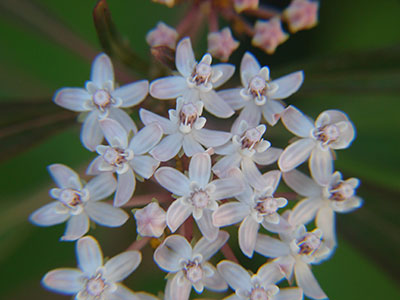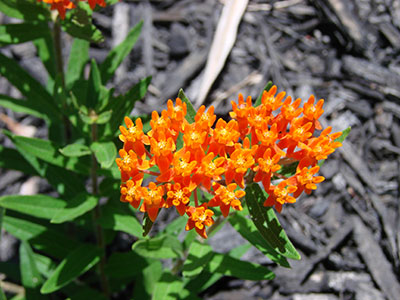Oviposition preference of monarch butterflies among milkweed species in Southern Indiana
Anna Jean Stratman, Julie Rabe, and Dr. Cris G. Hochwender
Introduction
Flagship species serve an important environmental purpose, generating public support for conservation goals beyond the needs of the specific species1. With their black and orange wings, monarch butterflies (Danaus plexippus) are the most easily recognized insect in North America. Because of widespread awareness, the monarch butterfly can act as a flagship species, encouraging support for the environment and increasing public engagement in ecological issues. The monarch's seasonal migration across North America can highlight conservation needs. Along their journey, monarchs lay eggs on milkweeds (Asclepias L. Gentianales: Apocynaceae). To complete their multi-generational migration successfully, land must be preserved in the Midwest, Canada, and Mexico. Conservation is increasingly important, both because monarch populations have decreased 90% and because milkweed populations have decreased nearly 70%2.
Engaging people by having them plant milkweed species that successfully attract monarchs may be the best way to promote monarch conservation. To this purpose, we observed oviposition preference of monarchs among four milkweed species native to Southern Indiana to determine which milkweed species attract monarchs.
Methods
Milkweed plants were grown and monitored at the University of Evansville's native plant garden in Southwestern Indiana. All four native species included in the study were herbaceous perennials: Asclepias syriaca (common milkweed), A. tuberosa (butterfly milkweed), A. perennis (thin-leaf milkweed), and A. incarnata (swamp milkweed). Each plant was given an individual identification, placed in a 10L pot, and randomly positioned on a brick patio to provide effective drainage at the start of the study (April 21, 2018).
Soil consisted of a mix using peat moss, top soil, and vermiculite (7:6:1 v:v). Plants were watered daily with the exception of days with rain. Three tablespoons of Osmocote Smart-Release® plant food (14:14:14 NPK) was applied to each pot 10 weeks after the start of the study. From April 21 to August 11, 2018, a total of 244 plants were monitored to evaluate oviposition by D. plexippus. Only 11 oviposition events occurred prior to August 11, preventing statistical analysis for preference during that time period. Unhealthy and damaged plants were removed from the study on August 11, 2018. The remaining 192 plants were evaluated from August 12 to September 30, 2018 for oviposition preference of resident monarch butterflies. To determine whether oviposition preference occurred among the four milkweed species, a chi-squared contingency analysis was performed3.
Results
From August 12 to September 30, monarchs laid at least one egg on 141 of 192 plants. Sixty-three percent of common milkweed, 66% of butterfly milkweed, 72% of thin-leaf milkweed, and 91% of swamp milkweed were laid on by monarchs. Significant preference among milkweed species was observed for monarch oviposition (X23 = 14.7; P=0.002).
Sixty percent of plants flowered throughout the year (115 of 192), with all but one butterfly milkweed and one thin-leaf milkweed flowering. Of the four species, swamp milkweed flowered both the latest and the longest.



Conclusion
 While monarchs exhibited significant differences in milkweed preference, with egg laying occurring on more than 90% of swamp milkweed, well above 50% of plants for every milkweed species were used for oviposition. These results suggest that monarchs value all four species for rearing caterpillars during the monarch's summer residency in Indiana.
While monarchs exhibited significant differences in milkweed preference, with egg laying occurring on more than 90% of swamp milkweed, well above 50% of plants for every milkweed species were used for oviposition. These results suggest that monarchs value all four species for rearing caterpillars during the monarch's summer residency in Indiana.
Gardeners may be motivated to grow all four milkweed species to raise monarch butterflies, but gardeners may also value the floral displays of milkweed. Flowers attract attention because of their appealing display and color. Therefore, species that have a higher proportion of flowering plants and plants that flower longer may be preferred by gardeners. Flowering from June through September, these four milkweed species provide a long seasonal display of flowers. All four species of act as host plants for female monarch butterflies. Using all four species can offer a variety of floral colors and blooming times for gardeners.
To educate the local community about monarchs and their host plant, students at UE grew over 1,000 common, butterfly, swamp, and thin-leaf milkweed plants to give to the public. Milkweed giveaway events were held at the University of Evansville, Wesselman Woods Nature Preserve, and John James Audubon State Park. Students also provided native seed packets for the public, hoping that the local gardening community would become inspired to invest in a variety of native plants for pollinators.
Acknowledgements
This project was funded by a grant from UExplore. We thank Hartman Arboretum, Deb Shade, and Chris Lee for their generous help.
Literature Cited:
- Guiney MS and Oberhauser KS. 2008. Insects as flagship conservation species. Terrestrial Arthropod Reviews 1: 111-123.
- Zaya DN, Pearse IS, Spyreas G. 2017. Long-term trends in Midwestern milkweed abundances and their relevance to monarch butterfly declines. Bioscience 67: 343-356.
- JMP, Version 14. 2018. SAS Institute, Cary, NC.
Office Phone
812-488-2024
Office Email
lk203@evansville.edu
Office Location
Room 231, Koch Center for Engineering and Science

